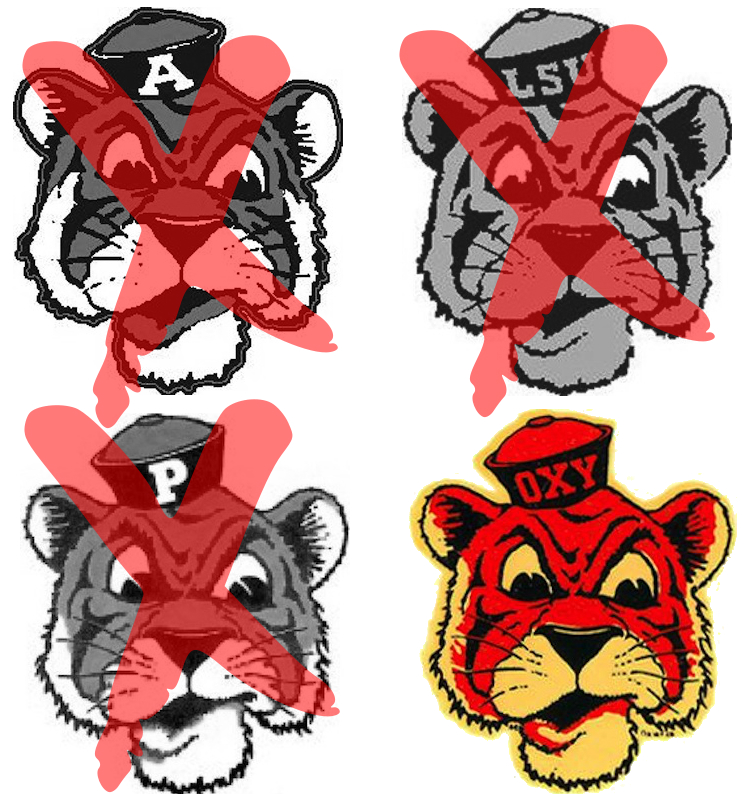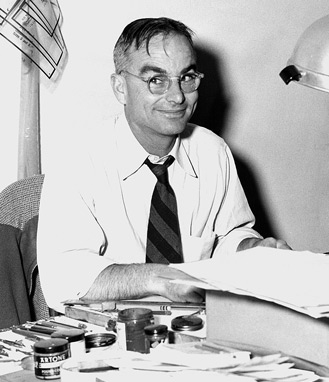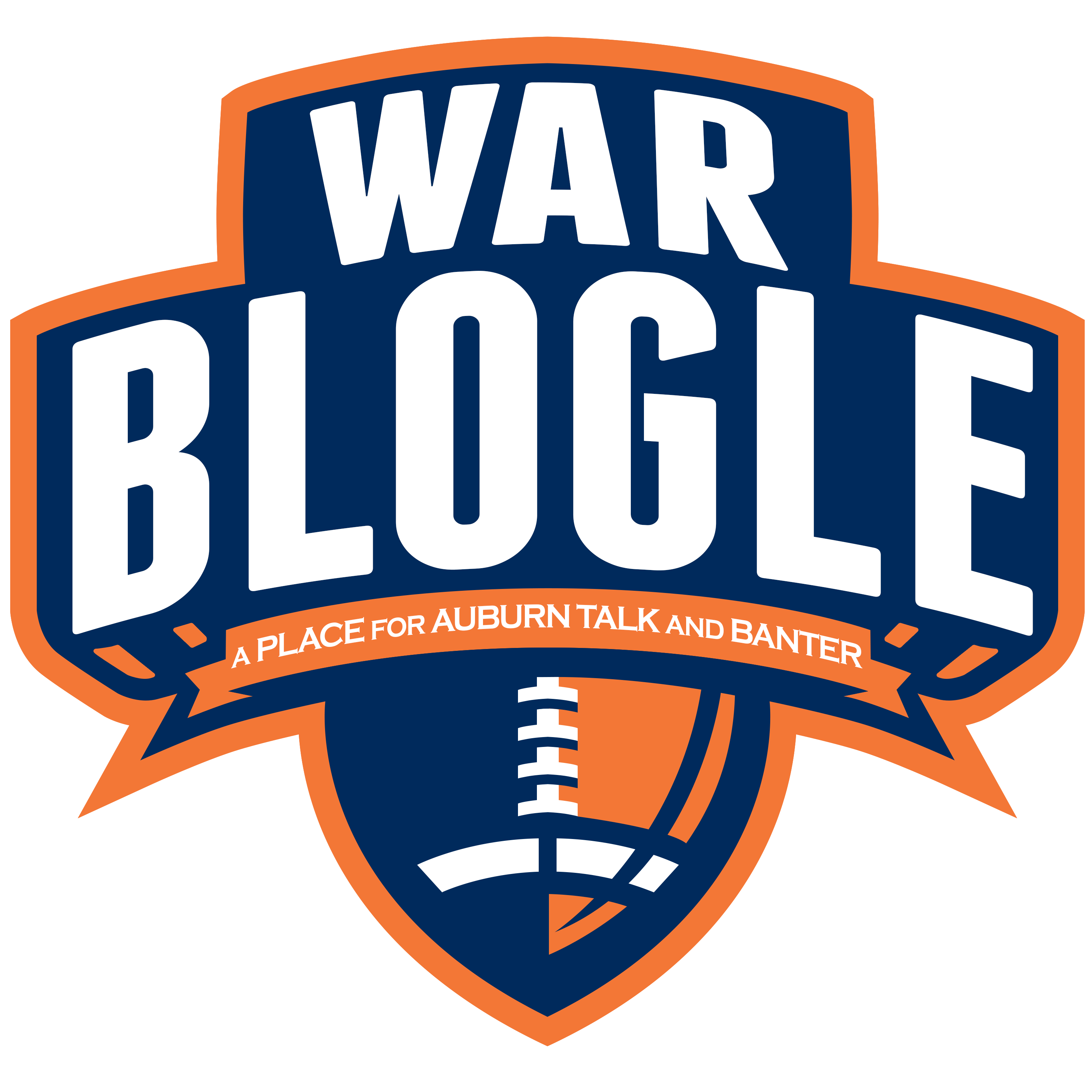 Back in February of 2012, I reluctantly wrote about what was believed at the time to be the true origin of the old tiger head logo that has recently made a resurgence with vintage collegiate clothing and collectibles. The logo has been used by Auburn, LSU, Princeton, Pacific, Missouri, and many other schools who call themselves the Tigers, the 2nd most used mascot in all of college sports (eagles are first). We can’t all be red water.
Back in February of 2012, I reluctantly wrote about what was believed at the time to be the true origin of the old tiger head logo that has recently made a resurgence with vintage collegiate clothing and collectibles. The logo has been used by Auburn, LSU, Princeton, Pacific, Missouri, and many other schools who call themselves the Tigers, the 2nd most used mascot in all of college sports (eagles are first). We can’t all be red water.
In short, I referenced an article written by an LSU student claiming that the logo was created by a W.A. Prescott of Brewton, Alabama, who was also an Alabama graduate. The article goes on to claim that Prescott moved to Baton Rouge during the 1930’s where he opened a family bookstore and created the old tiger head logo for LSU. At the point of me writing it, the dates, images, and backstory made it plausible that our beloved and widely used vintage tiger head logo was created by an enemy for another enemy. It hurt.
As I thought about it more, though, I realized that story made no mention as to how other schools would have picked up on and used the logo without any connection back to LSU.
Enter this article, written a year later by Dick Anderson of Occidental Magazine, that specifically refutes the story I originally posted. I’ll let you read the article for the full rundown, but I’ll give you a few highlights. It starts laying out the most well-known teams that have used the logo.
To alumni of the University of the Pacific in Stockton, he’s known as “Tommy Tiger.” Auburn University’s legions of football fanatics refer to him as “Aubie.”The nation’s 33rd president and Show Me State native provided the moniker for “Truman the Tiger” at the University of Missouri. But to devotees of Louisiana State University, he’ll always be “Sailor Mike.”
 As far as where the article claims this widely-used logo comes from, Anderson states that the tiger was a creation of a guy on the West coast named Arthur Evans. Evans was one of the most unheralded cartoonists of the time, but was responsible for dozens of mascot caricatures beginning way back in the 1920’s.
As far as where the article claims this widely-used logo comes from, Anderson states that the tiger was a creation of a guy on the West coast named Arthur Evans. Evans was one of the most unheralded cartoonists of the time, but was responsible for dozens of mascot caricatures beginning way back in the 1920’s.
One of his first jobs was to create a new tiger for Occidental College in Los Angeles. He created Oswald, which you know as the old tiger head logo, but with “OXY” on his hat instead of the Auburn “A.” Evans’s work ended up getting into the hands of a businessman who took his portfolio across the country.
Unlike the original article, Anderson’s includes extensive research and quotes linking the creation of the logo back to Evans.
Arthur Evans—head artist for the Angelus Pacific Co. of Fullerton from 1932 until his retirement in 1977— [was given] the moniker of “Most Prolific Cartoonist,” reporting that he was responsible for at least “90 percent of the college mascots” being used at the time. “Art Evans is a legend around here,” longtime Angelus office manager Jean Ruppe is quoted as saying. “Colleges and high schools would send a rough idea of what they wanted, and Art would get busy and come up with a sports mascot.”
“Your Oswald was drawn by Arthur Evans—Dad always said you could tell Arthur’s work by the eyes,” says Tim Waddell, president of Angelus since 1993 … But as to where he appeared first—well, that’s anybody’s guess. “Back when your tiger was originally done, nobody had even heard the word licensing,” Waddell says. “If Art drew a good tiger and somebody wanted a tiger, we used it.”
Yes, Waddell basically says that they don’t know what school used it first, but given that Arthur was literally a few miles from Occidental College, it’s a pretty good assumption that it started there. It definitely didn’t start in Baton Rouge, or Auburn, or New Jersey.
Anderson’s article then goes on to reference my original post’s claim of Prescott being the creator:
The resurgence in popularity for some of Evans’ classic creations suggests that newer isn’t necessarily better. And more than 70 years after his creation, feelings for Classic Oswald run deep among his many suitors.
There’s no supporting evidence to suggest that Prescott had a hand in the creation of the logo; in its own literature, Angelus refers to the image as the “Auburn Comic Tiger.” But part of the appeal of Sailor Mike to LSU fans “is that it was one of the primary tiger marks used during a very successful period for LSU athletics which included the university’s first football national championship [in 1958],” says Brian Hommel, director of LSU Trademark Licensing.
Wait, did you see that? The Angelus Pacific Co. of Fullerton, which employed Evans as their head artist, calls the image the “Auburn Comic Tiger.” That’s interesting. If this was LSU’s logo, as the original article and most LSU fans claim, wouldn’t it be called Sailor Mike? Again, this is the company that was responsible for hiring the man who created it. They would probably know. It sounds to me like LSU wants to claim it just because they were good at the time the logo became popular.
When it comes down to it, there is no clear answer on who the logo was created for, but we can be sure it was not made for LSU or by an Alabama graduate. It most likely started at a small college in Los Angeles, only a few miles from the Arthur Evans, and made it’s way East.
If the company that employed the creator calls it Auburn’s, it could be Auburn’s to claim, but I’m fine with letting Oxy have this one, as long as we can keep using it. Especially since my gameday shirt this year features Oswald/Aubie and is currently 3-0.
Now, don’t you feel better about all of those old tiger head t-shirts and hats you’d felt bad about wearing for the last 18 months? Wear them with pride. I’ll be wearing mine in Baton Rouge tomorrow night. I might even tape OXY over the A. Well, let’s not go that far. Occidental College probably has a terrible football team.
OH WOW. Just checked and they lost their 2013 season opener 67-30… to the Pacific University (Oregon) Tigers, most likely one of the first teams outside of Occidental to use the logo. This is too weird. That had to be awkward…
Update: a commenter points out that the University of Pacific (Stockton, CA) used the old tiger head logo, not Pacific University. So yeah, not as awkward.

11 comments
So much of that LSU story seemed too good to be true. It was originally for LSU, made by a Bama grad, WHO ALSO FOUNDED J&M? Glad we cleared the air on that one. The dates are the other issue that this may clear up. Auburn’s “1950s” assumption is completely wrong due to the fact that the logo is in as early as 1945’s Glom (on a mass produced radio). I have one from 1947, so it had to have been used before then to make it onto a radio in 1945.
So the takeaway here is that all corndogs are liars.
Aw come on! ALL are LIARS? You and I both know that college football is rich with superstitions, folklore, and legends. Stories are made up every day to make simple things connected to your university seem more interesting and important. As an LSU fan, I love all of my Sailor Mike t-shirts and other stuff and I would like to think that everything was created by God himself specifically for us corndogs. This is obviously not true but it’s just fun to believe it that way. Auburn fans and fans of every school around the country do the same thing. Perhaps some guy a long time ago stole a tiger logo and brought it back to LSU and claimed he had created it for LSU. Old dude might have made some money off of it then traveled down the road and sold it to Auburn the same way. That doesn’t make us all liars. In fact, in the days before the internet, no one would have had any reason to believe otherwise. A new logo showed up with LSU written on it. It is ours! Mr. Kris McInnis was right on in his comment below. With all the subtle differences, it is nothing more than a 1940’s equivalent of a Google search for tiger clipart.
This was an interesting article. The best part was, “we can’t all be red water.” Hahaha. Something Auburn and LSU can agree on.
Thanks Auburn fan.
From,
LSU fan
Alabama played in the Rose Bowl (in Los Angeles) in ’26, ’27, ’31, ’35 and ’38. It’s very easy to believe that a Bama grad stole the logo after seeing it while in LA and took it with him to another LA.
Good read! Thanks for doing the detective work.
I just LOVE History, don’t you? Seriously good article that goes to show you a lot of things! Which again is why I LOVE History! You notice the “Back when your tiger was originally done, nobody had even heard the word licensing,”? Sadly that makes one really see how “far we have progressed” when we have to worry about being sued over the use of a cartoon image!
Anyway, good article and thanks for the info!
“OH WOW. Just checked and they lost their 2013 season opener 67-30… to the Pacific University (Oregon) Tigers, most likely one of the first teams outside of Occidental to use the logo. This is too weird. That had to be awkward…”
It was actually University of the Pacific (Stockton, CA) that used this logo, not Pacific University. As references earlier in the article it is known there as Tommy the Tiger. University of the Pacific has not fielded a football team since the mid-90’s.
The mascot for Pacific University in Oregon is the Boxer.
This paragraph makes you sound like a 2nd grader who has had his toy taken away….
“Wait, did you see that? The Angelus Pacific Co. of Fullerton, which employed Evans as their head artist, calls the image the “Auburn Comic Tiger.” That’s interesting. If this was LSU’s logo, as the original article and most LSU fans claim, wouldn’t it be called Sailor Mike? Again, this is the company that was responsible for hiring the man who created it. They would probably know…..”
I have noticed that the color patterns on most of the tigers are inconsistent or altogether different. I have a feeling that W.A. Prescott, more than anything else, was responsible for the re-coloring of the LSU version of the tiger head as the majority of the pictures of the logo across various other schools typically color the fur subtly different from the others, such as the white bits not going all the way up the the ears, etc. So while his family might insist that he created the logo and truly believe so, essentially (as you alluded to) it’s really nothing more than the 1940’s equivalent of a Google search for clip-art tigers that Prescott and others managed to pluck and manipulate before modernized licensing practices.
The biggest wrong I see with this article is the lack of actual college football knowledge. For example, 1958 was not LSU’s first “MYTHICAL” national championship season in football. As it was only their first “CLAIMED MYTHICAL” national championship season in football. 1908 was LSU’s first awarded “MYTHICAL” national championship season in college football, which also was the very first time that a southern football playing school was ever awarded as the “MYTHICAL” college football national champion. LSU followed their 1908 “MYTHICAL” college football national championship season up with “MYTHICAL” college football national championship seasons in back to back years in 1935 & 1936. Yes the commonly referred to first season of the AP Poll in 1936, which itself is wrong as well. 1934 was the actual first season for the AP Poll, with there not being an AP Poll in 1935. The AP Poll again appeared in the 1936 season and has every year since. The 1936 AP Poll voted a 1 loss Minnesota team as the AP Poll “MYTHICAL” national champion over an undefeated LSU team. Yet the AP poll, Coaches Poll, the old UPI Poll, Bowl Coalition, BCS system or even today’s College Football Playoff all are no more legit than any other awarding service when it comes to naming a “MYTHICAL” national champion in college football at the FBS level each season, simply because the NCAA doesn’t award or recognize an NCAA national champion in college football at the FBS level, nor have they ever given any outside source the authority to name an NCAA national champion in college football at the FBS level each season for them. Hence, the reason why it’s actually called a “MYTHICAL” national championship, instead of a real NCAA awarded & recognized national championship. Therefore leading to more awarding services recognizing LSU as their “MYTHICAL” college football national champions for the 1936 season than how many recognized Minnesota as their “MYTHICAL” college football national champions for the 1936 season. That in turn made the 1958 season LSU’s 4th college football national championship season, not their 1st. LSU has been awarded by at least one or more awarding services of the time as the “MYTHICAL” FBS football national champions in 9 different seasons, 1908, 1935, 1936, 1958, 1959, 1962, 2003, 2007 & 2011. With LSU being a school that chooses to only “CLAIM” major wire service awarded “MYTHICAL” FBS football national championships, they only “CLAIM” 1958, 2003 & 2007 as being “MYTHICAL” FBS football national championship seasons for the school. LSU is also the SEC’s All-Time leader with 44 NCAA awarded & recognized national championships to their credit. Therefore anyone can argue back & fourth about who was the first to use that tiger head logo, but no one can dispute who has been the most successful sports program to use that logo.